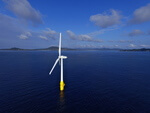02/10/2010
USA - Wind turbine to be tested for resistance against earthquakes
UC San Diego researchers will shake a 80-foot, 23,400- pound wind turbine in a series of simulated earthquakes of up to 7.0 magnitude, to see how “non-building” structures can be built more temblor-resistant.
The turbine will be placed on a shake table — a computerized, hydraulic- powered platform that can replicate the motions and forces of specific earthquakes or seismic events. The San Diego Union-Tribune reported that the 40- foot-by 25-foot structure at UCSD’s Englekirk Center is the world’s largest outdoor shake table.
Monday’s test will be observed by representatives of the wind-energy industry, the newspaper said. Many of the upgrades to seismic standards in recent years have resulted from such testing. According to the California Energy Commission, the ability of wind turbines to withstand earthquakes and remain functional is a question of growing relevance.
The thousands of wind turbines in San Grogonio Pass near Palm Springs sit directly atop the San Andreas Fault at an area long believed by seismologists to be overdue for a mammoth earthquake. Three years ago, 2,439 wind-farm turbines produced about 2.3 percent of the state’s overall system power.
That percentage will rise because state law requires California’s large, investor-owned utilities to generate 20 percent of their power from renewable sources at the end of the year, the Union-Tribune reported. Gov. Arnold Schwarzenegger has proposed a goal of 33 percent by 2020.
“I expect we’re going to see a vast increase in wind farms, which gives more importance to this work, especially since more turbines will be deployed in areas with seismic activity,” Ahmed Elgamal, a UCSD professor of structural engineering, told the Union-Tribune.
“You just don’t want these structures to fail. That slows recovery,” added Frieder Seible, dean of UCSD’s Jacobs School of Engineering. “After an earthquake, you need highways and bridges to remain open. You need energy systems to continue working.”
Turbines are upright steel tubes typically bolted to a concrete foundation with a set of spinning blades and a nacelle filled with machinery at the other end. The newest models are two to three times taller than the one being tested by the UCSD researchers.
For more information please contact Trevor Sievert at ts@windfai.net
The turbine will be placed on a shake table — a computerized, hydraulic- powered platform that can replicate the motions and forces of specific earthquakes or seismic events. The San Diego Union-Tribune reported that the 40- foot-by 25-foot structure at UCSD’s Englekirk Center is the world’s largest outdoor shake table.
Monday’s test will be observed by representatives of the wind-energy industry, the newspaper said. Many of the upgrades to seismic standards in recent years have resulted from such testing. According to the California Energy Commission, the ability of wind turbines to withstand earthquakes and remain functional is a question of growing relevance.
The thousands of wind turbines in San Grogonio Pass near Palm Springs sit directly atop the San Andreas Fault at an area long believed by seismologists to be overdue for a mammoth earthquake. Three years ago, 2,439 wind-farm turbines produced about 2.3 percent of the state’s overall system power.
That percentage will rise because state law requires California’s large, investor-owned utilities to generate 20 percent of their power from renewable sources at the end of the year, the Union-Tribune reported. Gov. Arnold Schwarzenegger has proposed a goal of 33 percent by 2020.
“I expect we’re going to see a vast increase in wind farms, which gives more importance to this work, especially since more turbines will be deployed in areas with seismic activity,” Ahmed Elgamal, a UCSD professor of structural engineering, told the Union-Tribune.
“You just don’t want these structures to fail. That slows recovery,” added Frieder Seible, dean of UCSD’s Jacobs School of Engineering. “After an earthquake, you need highways and bridges to remain open. You need energy systems to continue working.”
Turbines are upright steel tubes typically bolted to a concrete foundation with a set of spinning blades and a nacelle filled with machinery at the other end. The newest models are two to three times taller than the one being tested by the UCSD researchers.
For more information please contact Trevor Sievert at ts@windfai.net
- Source:
- Online Editorial www.windfair.net
- Author:
- Trevor sievert, Online Editorial Journalist
- Email:
- ts@windfair.net
- Link:
- www.windfair.net/...
- Keywords:
- wind energy, wind power, wind turbine, rotorblade, renewable energy, offshore, onshore


























